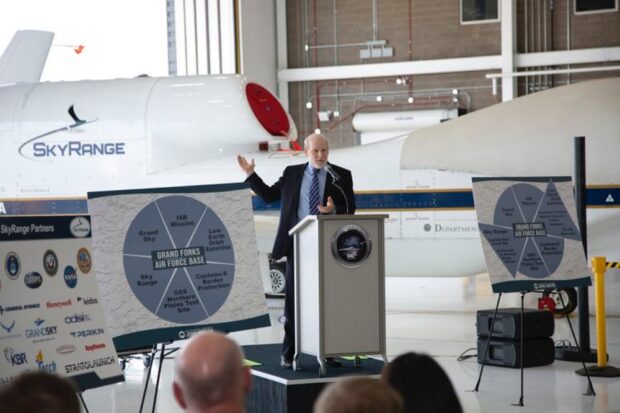Northrop Grumman is now adapting the next two RQ-4 Global Hawk drones into aircraft that can monitor hypersonic system tests and expects to start integration testing on the pair later this summer.
In an interview with Defense News, Northrop Grumman executive Doug Shaffer said the company is on track to deliver those aircraft, newly modified into Range Hawks, to the Defense Department’s Test Resource Management Center by early 2025.
These two Range Hawks are the first to be modified from a batch of 24 Global Hawk drones the Air Force has retired in recent years and passed on to TRMC for a second life as flexible and airborne test data collectors.
In the past, the government has used sensors mounted on ships to collect test launch data for hypersonic systems. But moving those ships into the proper positions can be a lengthy and laborious process that requires a substantial number of people.
So in recent years, the Air Force, NASA and TRMC have been working on a concept called SkyRange to mount sensors onto Global Hawks that could more easily collect this data. The program’s first three adapted RQ-4s — which were older Block 10 models — in recent years have been supporting tests for programs such as NASA’s Artemis Moon exploration program and hypersonic vehicles. They are stationed at the Armstrong Flight Research Center at Edwards Air Force Base in California.
In an interview with sister publication C4ISRNet, TRMC director George Rumford said having those early Range Hawks allowed the Pentagon to conduct virtually back-to-back hypersonic flight tests in early 2023, 10 days apart over the Atlantic and Pacific oceans.
Northrop Grumman said the first three Range Hawks performed so well that TRMC is moving to expand the SkyRange program. The two dozen Block 20 and 30 RQ-4s that are slated to be modified into the next several batches of Range Hawks are more capable than the older model.
Technology has advanced enough in recent years to be able to shrink the sensing equipment down enough to be mounted on a drone, said Shaffer, vice president of intelligence, surveillance, reconnaissance and targeting programs for Northrop Grumman’s aeronautics systems sector.
Shaffer said Northrop Grumman has started breaking down these first two RQ-4s at the Grand Sky facility near Grand Forks, North Dakota, and will start installing the new suite of sensors as parts come in. Once mounted on the Range Hawks, the sensors will be able to gather telemetry data on hypersonic launches such as speed and trajectory, he said.
These Range Hawks have now passed their critical design review, and the design process is now finished, Shaffer said. Northrop Grumman used digital design techniques, he said, which has sped up the process.
Northrop Grumman plans to modify the remaining RQ-4s in batches of four, Shaffer added, starting with the Block 30s. And with each RQ-4′s modification taking roughly eight months to complete, he said, updating the entire fleet could take several years. He cautioned that schedule will depend on whether the program continues to get enough funding.
Shaffer declined to say how much each updated Range Hawk will cost, but said later modifications will grow cheaper as work on the program progresses.
The Air Force now has nine RQ-4s left in its inventory and plans to eventually retire them. But in the latest National Defense Authorization Act, lawmakers moved to prevent the Air Force from mothballing the remainder of its fleet until after fiscal 2028.

